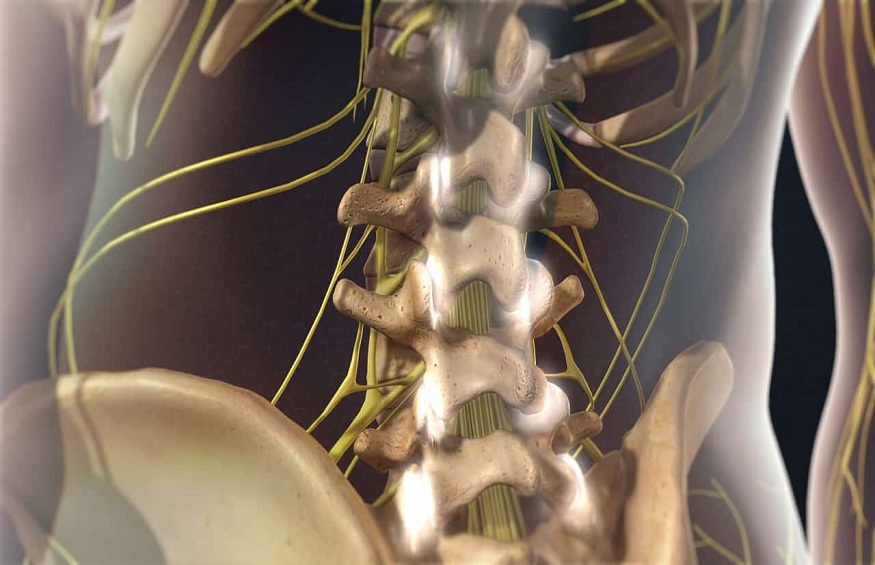What is a facet infiltration?
The facet joints are the joints that connect the different vertebrae to each other. These joints play an important role in the stability and movement of the spine. When the pain is at the origin of these facet joints, an infiltration of these facets can be considered.
When should we consider this infiltration?
With age, facet infiltration can be deformed. Often this is accompanied by osteoarthritis and a local inflammatory response. This produces typical pain in the spine.
Irritation of the facet joints of the neck (cervical) can lead to pain that sometimes radiates into the shoulder and trapezius. Often there is also a decrease in the movements of the cervical spine.
Irritation of the facet joints in the lower back (lumbar) can lead to pain (often band-shaped) which can radiate to the breech, in the inguinal area, in the hip area or in the thigh.
What is the purpose of this infiltration?
Two types of facet infiltration can be considered: therapeutic and diagnostic.
A therapeutic infiltration of a painful facet joint consists of the local injection of corticosteroids (= a product with the effect of cortisone): this reduces the inflammatory response and the swelling induced.
It can ease the pain. It is common to experience a temporary increase in pain (not alarming). The analgesic effect often appears after a few days (typical of corticosteroids). Depending on the result, the treatment can be repeated no earlier than two weeks after the first infiltration.
A diagnostic painful facet joint infiltration involves the local injection of an anesthetic into the nerve branches of the facet. This helps confirm the origin of the pain.
what are the results?
Often, after infiltration of the veneers, a temporary or partial improvement in symptoms is noted. A guarantee of improvement cannot be given as the underlying cause (eg wear) is not eliminated by infiltration.
Diagnostic facet infiltrations should be considered a “test treatment” to determine if the affected nerve branches are causing the pain. If there is a good temporary effect (at least 50% improvement) for 24 hours after infiltration, denervation can be considered with the help of a high frequency electric current.
HOW? ‘OR’ WHAT
You must not be fasting during a facet infiltration.
Anticoagulants should generally be stopped and if necessary replaced by injections of Clexane or Fraxiparin (stop 24 hours before the injection).
Since we use x-rays for injections (required for precise positioning), you cannot be pregnant. This radiation is indeed potentially dangerous for your future child.
An injection of a local anesthetic and / or corticosteroids is given to the facet joint.
Denervation of the facet joint is carried out by a high frequency electric current.
FACET INFILTRATION
During the infiltration, you will have to position yourself on your stomach.
The doctor will disinfect your back and put a towel on your back or neck.
Then he will administer local anesthesia.
Then, he will position the needle at the level of the facet joint. This is normally not painful.
It is very important not to move during the procedure!
After having checked the correct positioning of the needle by fluoroscopy, the drugs are injected.
This may give your symptoms a short-term increase or a feeling of electricity. Definitely mention your doctor.
After the infiltration, you will be taken to the recovery room on a lounge chair, where you will be observed briefly.
Then a nurse will come and pick you up.
You can change your clothes and go home.
FACET DENERVATION
During the infiltration, you will have to position yourself on your stomach.
The doctor will disinfect your back and put a towel on your back.
Then he will administer local anesthesia.
Then, he will position the needle at the exit of the nerve root, at the level of the foramen. This is normally not painful.
It is very important not to move during the procedure!
The correct positioning of the needle will be checked by fluoroscopy and by electrical stimulation.
For this we need your cooperation.
First, the sensitivity is tested, to see if the needle is placed close enough to the painful area. It is important that you signal that you feel “something” on your back. It can be pressure, or tingling. Pain is not necessary here!
Then we test if we are far enough from the nerves in the leg. You will feel shocks (contractions) in your back. Your doctor will determine if this stimulation is correct.
The local anesthetic is administered and shortly after denervation is started. It can make the back feel warm.
If this is painful or difficult for you, you must tell the doctor. Treatment will be interrupted temporarily if necessary.
After the treatment, you will be taken to the recovery room where you will be observed briefly.
Then a nurse will come and pick you up.
You can change your clothes and go home.
SIDE EFFECTS AND COMPLICATIONS
Although the technology and products are very safe, some side effects and complications are described:
• Temporary pain at the puncture site is not uncommon but not very bothersome.
• The corticosteroid can have side effects such as (temporary) weight gain, muscle weakness, flushed face, blood sugar disturbance, and bone loss (osteoporosis). These side effects usually occur if you have had several successive infiltrations.
• After the injection, your blood pressure and heart rate may drop temporarily. This is often due to local anesthesia; temporary dizziness can be described. Therefore, you will be monitored for some time after the procedure.
• Allergic reactions to latex, disinfectant, contrast medium or administered drugs are possible. Always tell the nurse or doctor if you have any known allergies.




